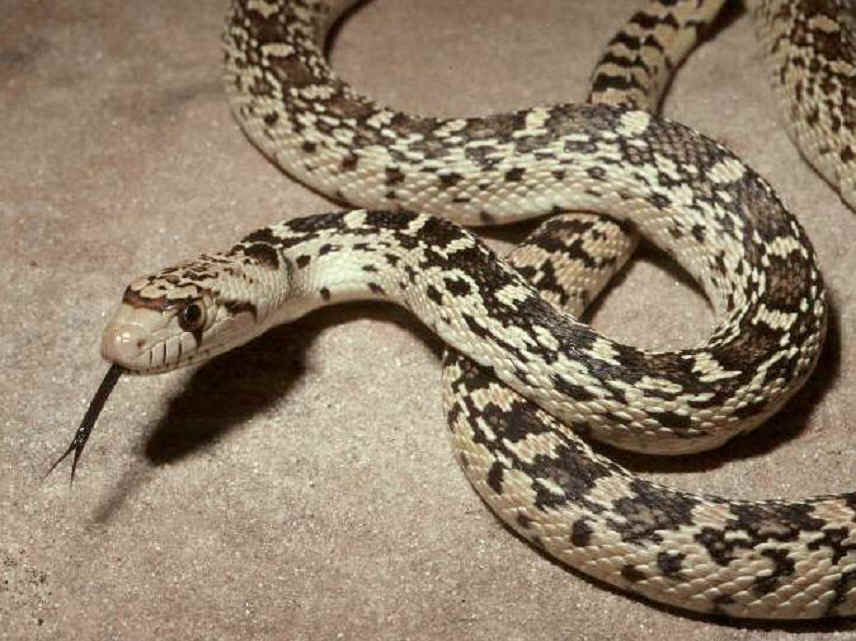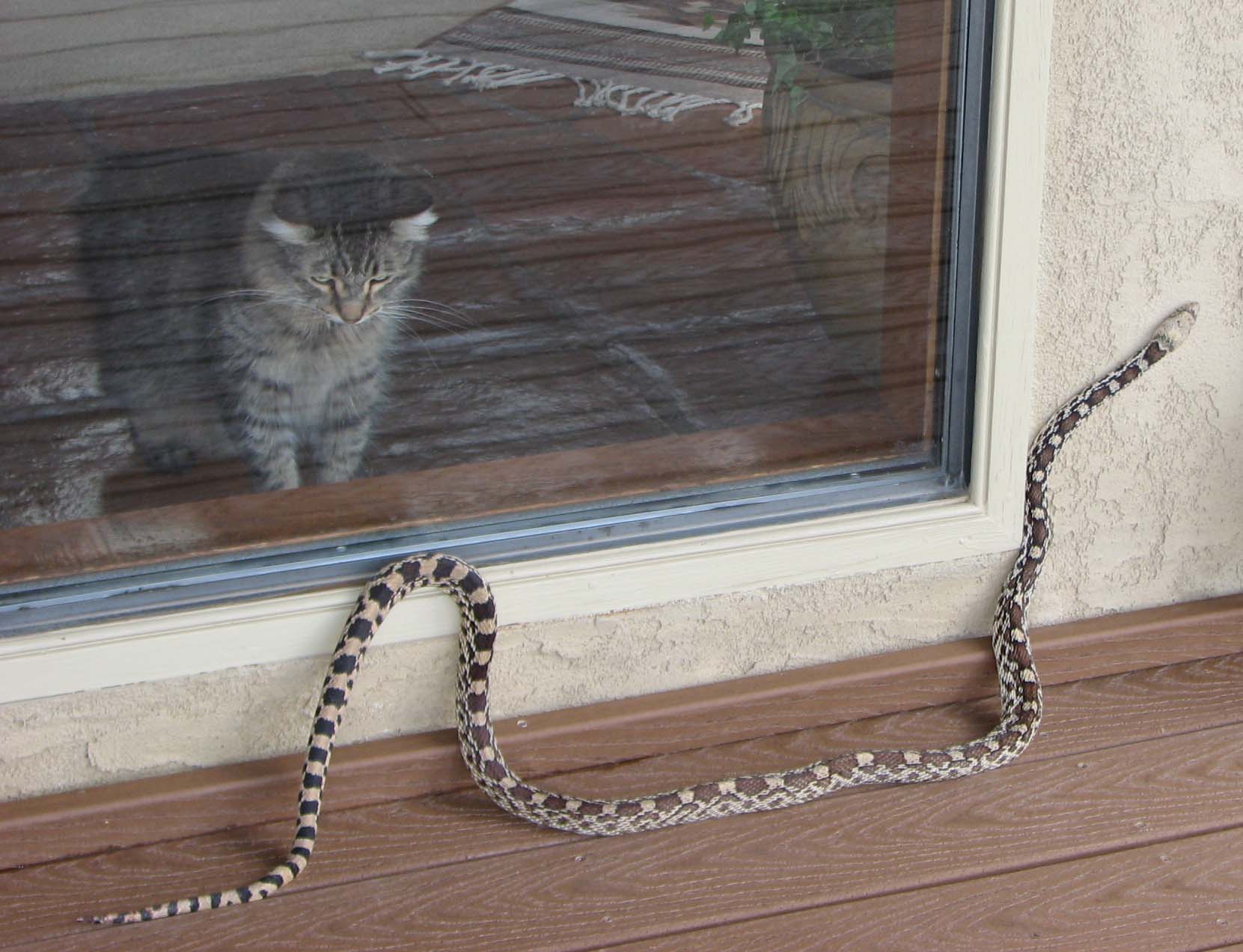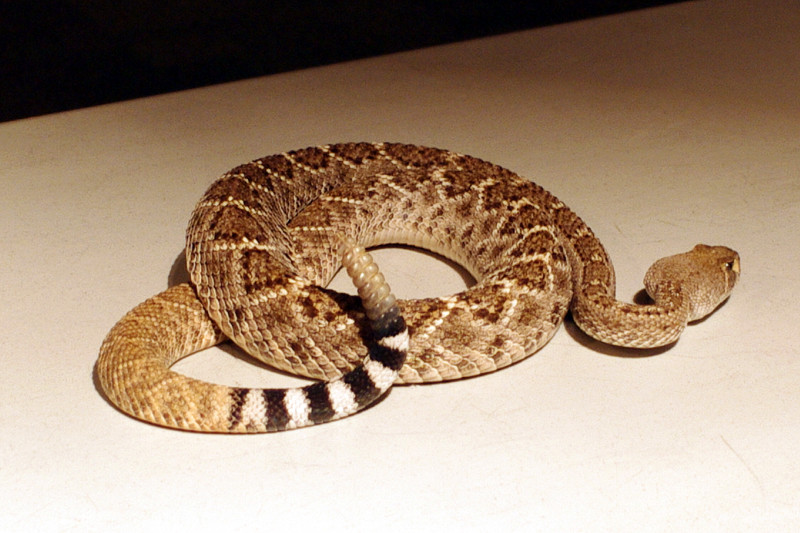SNAKES? Sandia Heights residents have mixed feelings about snakes—some people like them and some people don’t. So I’d like to speak in defense of snakes. I hope to help folks see snakes in a different light.
Humans seem to be hard-wired to be afraid of snakes, even if they have never seen a snake. Living in Sandia Heights, we share habitat with several kinds of snakes, the most common of which are bull snakes (also called gopher snakes) and rattlesnakes. Only the rattlesnake is venomous, but all snakes are vital to controlling the rodent population. So please try to see snakes as friendly. All right, I can hear the reaction already! If you can’t bring yourself to like snakes, at least leave them alone and think about how many more mice would be trying to get into your house without them. Understandably, you may not want a rattlesnake taking up residence outside your back door. If this happens to you, Sandia Heights Security will be happy to remove it and bring it to my house. Just kidding!
I’m going to talk only about rattlesnakes and bull snakes here, because bull snakes are most often mistaken for rattlesnakes. Rattlesnakes and bull snakes have similar coloring, with black and brown markings on their backs. This is no accident. Bull snakes try very hard to look and act like rattlesnakes. When threatened, they will coil and raise their heads, hiss, and rustle their tails in dry leaves to mimic a rattle. However, they are nonvenomous constrictors that kill their prey by squeezing, and they pose no threat to humans or pets. One foolproof distinction is the shape of the pupils of the eyes (rattlesnakes have vertical, football-shaped pupils and bull snakes have round pupils), but most people don’t want to get anywhere near close enough to tell the difference that way! The easiest way to tell the difference is to look at the head: a rattlesnake has a distinctly triangular head with pronounced eye ridges and a neck that is narrower than the head, while a bull snake’s head is roughly cylindrical and the same diameter as its neck. The other obvious difference is the body shape. Rattlesnakes are larger in diameter relative to their length and are fattest in the middle of the body, with a blunt tail ending in several rattles in adult snakes. Bull snakes are more or less the same diameter the entire length of their body. A five-foot-long rattlesnake may be three or four inches in diameter in the middle of its body, while a five-foot-long bull snake is probably about an inch and a half in diameter. These photos show the differences very clearly:
The first two photos are bull snakes (Pituophis catenifer)


This is a western diamondback rattlesnake (Crotalus atrox)

Both bull snakes and rattlesnakes are shy and will try to avoid people. They usually know you’re approaching from the ground vibration, and given the chance they will usually crawl away. They won’t chase you! If you see a snake, it’s probably stretched out on the pavement or on a sunny trail catching rays. Snakes are reptiles, and the only way they can regulate their body temperature is by moving to a warm area (like sun-warmed asphalt) to get warm and to a cool area (under a tree or in the shade of a rock) to cool off. This affinity for getting warm by stretching out on pavement gets many snakes killed by cars, when drivers don’t see them in time to stop. Unfortunately, some people go out of their way to run over snakes. Please don’t let this be you! If you see a snake basking on the road, try to drive around it. If you encounter a snake while walking on the trail (or on the road, for that matter), you can jump up and down or stomp your feet to create vibrations that the snake will feel. Then just wait until the snake moves away. But if a rattlesnake responds by coiling and rattling, it’s best to take a detour!
Growing up in Albuquerque in a family that loved hiking and camping, I learned very early (thankfully not the hard way) “Never put your hands or feet any place you can’t see”. If you follow this advice, you won’t step on a rattlesnake and you won’t get bitten.
In the unlikely event you are bitten, don’t panic! Call 911 and keep the bite area lower than your heart to slow the spread of venom. Snakebite kits are useless and may even make things worse. Rattlesnake venom is a potent toxin that kills nerves and tissue, so the best thing you can do is to get to a hospital as quickly as possible where you can get antivenin. Dogs sometimes get bitten because they are curious and will put their face right up to a snake to see what it is. If this happens, get the dog to the veterinarian as fast as you can. It’s another good reason to keep dogs on leash when you walk them on the streets or on trails.
If you see a snake near your house, please please leave it alone. You’ll probably never see it again. Rest assured it will gobble up mice and other rodents and keep the population under control. There’s never a good reason to kill a snake—they are an essential part of our wildlife habitat.